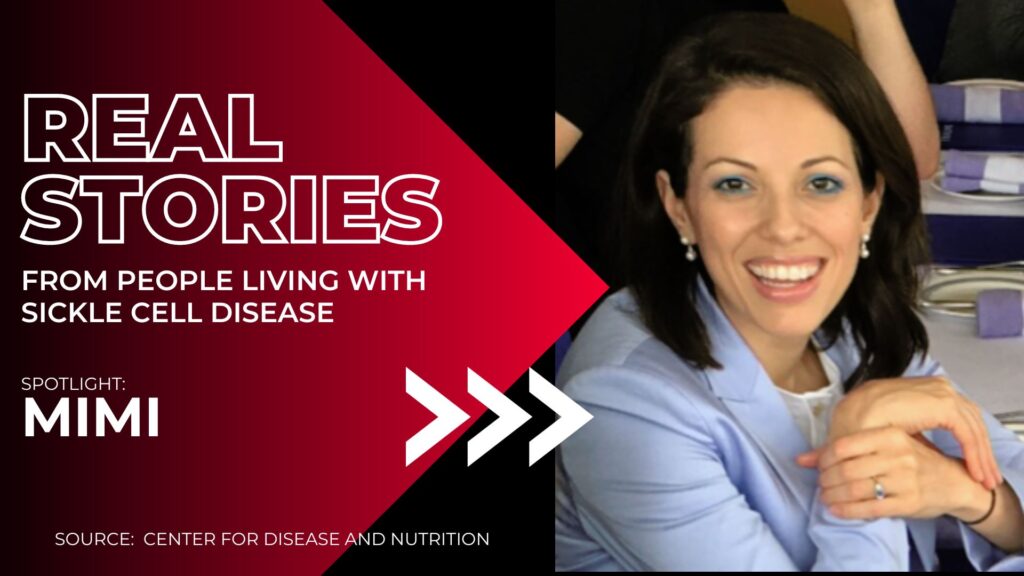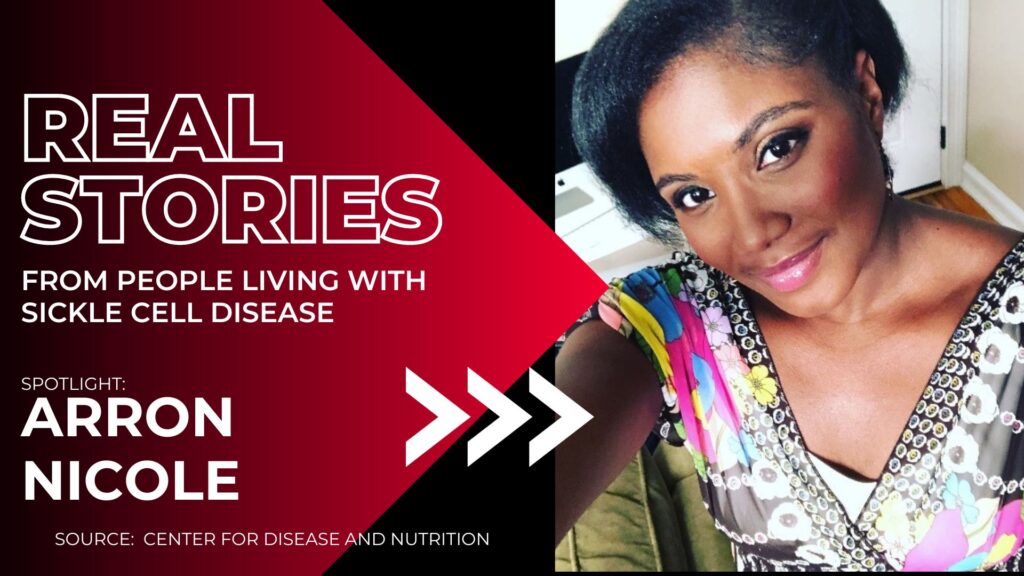Real Stories from People Living with Sickle Cell Disease: Mimi

Mimi’s Story
Sickle cell disease (SCD) is an inherited blood disorder that can cause pain, anemia, infection, and other serious health problems. Although the exact number of people with SCD is unknown, estimates suggest that approximately 100,000 people in the United States are affected by SCD.
“When I’m in that moment of pain in the emergency room, I can’t even think for myself. The pain is debilitating and they’re asking me questions like, ‘Are you sure you have sickle cell? We need to look into this,’” says Mimi, a 37-year-old lawyer and mom of four.
Mimi’s medical history is similar to that of many individuals with sickle cell disease (SCD): she has experienced severe pain since a young age, frequently sought care in the emergency department (ED), and has received numerous blood transfusions (when healthy blood is given to a patient through one of their blood vessels). But Mimi’s genetic (inherited) blood disorder comes as a surprise to many healthcare providers when they first meet her because of one detail: she’s not African American.
A commonly held myth about SCD is that it only affects individuals of African descent. Although SCD is most common among African Americans in the United States, it can also affect Hispanics, and people whose ancestors come from countries in South Asia (such as India), southern Europe (such as Greece and Italy), and the Middle East (such as Saudi Arabia and Lebanon).
SCD is a disease one is born with and is now a part of the newborn screening program for all states. But because Mimi was born before this program started in her state, she was not diagnosed until she was 5. Because of Mimi’s Arab American background, a sickle cell diagnosis did not occur to many of her healthcare providers. “I was about 3 years old when I started presenting with pain in my wrists and ankles. My parents would take me to the emergency room and the doctors would take an X-ray. They wouldn’t be able to find anything; they would just send me back home. My parents had psychologists telling them I was faking the pain,” recalls Mimi. It wasn’t until one particular doctor requested a blood test that her family discovered she has SCD.
Throughout her life, healthcare providers have doubted Mimi when she told them she had SCD. This has caused delays in Mimi getting the treatment she needs. “I’ll have to wait for the blood work to come back for them to help me with anything. I’ll have to wait several hours in the emergency room for any sort of pain relief,” says Mimi.
Like many individuals with SCD, Mimi’s pain has been dismissed in the ED several times. “This has happened as recently as the last 2 years, where they’re extremely dismissive. And I have to explain to them step by step what’s going on, what I need. I just need some pain relief. They may give me a little bit, but they send me home,” she says.
What is going through Mimi’s mind during these frustrating experiences? “It’s just the pain. Like please make it stop. There is nothing else you can think about except, please make it stop, please hurry. I’ve been in tears; I would be crying and waiting. I remember a nurse many, many years ago who told me, ‘Relax, it’s not that much of a big deal.’ That is extremely frustrating,” says Mimi.
Although Mimi has had negative experiences seeking health care for her SCD, she’s also had some great experiences. “I’ve had some amazing providers, some absolutely wonderful doctors and nurses who know my history. My hematologist (a blood disorder specialist) here in Atlanta told me, ‘You just come in and we will see you immediately.’” During her time living in Sydney, Australia, Mimi had a hematologist who was always on standby along with his team ready to take her in during an SCD-related health issue.
While Mimi has been through many challenges as someone with SCD, she says her condition has only encouraged her to be “grateful for every minute.” Growing up, she loved to be active in extracurricular activities at school including ballet, jazz, and swimming, but would often have to miss practices and performances when she ended up in the hospital for pain or other SCD-related health issues. “I hated being in the hospital as a child. I’d be so grateful when I came out. Just be thankful for every moment that you have.”
Mimi credits her motivation in life and her career to having missed out on so much as a child because of her condition. Originally from Atlanta, Georgia, Mimi moved to Sydney, Australia for school because she felt it would be a fun experience. She ended up starting a family there, which includes her four children, and living in Sydney for 18 years.
These days, Mimi is back in Atlanta with her family and getting ready to take the bar exam (a test every lawyer has to pass before becoming licensed to practice law) in February 2020. After passing the bar, she looks forward to practicing family law. “People always say to me, ‘Just relax, take it easy.’ I can’t, I just can’t. I have to follow the next thing,” Mimi says with a laugh.
What is Mimi’s advice for others with SCD?
– Develop a relationship with your doctor. “If you don’t have a great relationship with your doctor, move on to someone with whom you can because they will be the person who really has their eye out for you.”
– Build a strong support system. “Make sure you have parents, friends, family members, a spouse, whoever. I wasn’t too upset that I didn’t have a community support system as a child because I had a phenomenal one at home.”
– Ask for help. “Pick up the phone and say, ‘Please help me out.’ Don’t be afraid to ask for help right away when you need it. Don’t be afraid to tell people exactly how bad it is.”
Mimi hopes for better knowledge of and care for people with SCD. “Rapid intervention makes all the difference. Knowing that just because I look a certain way doesn’t mean that I’m not in the same amount of pain. I would like to see change from the bottom up; I’ve had issues all along at all levels,” she says.
Mimi’s story shows how important it is for healthcare providers, community workers, policy makers, and other supporters of SCD to know that SCD affects diverse groups so that all people with SCD can receive timely treatment for SCD.






Responses